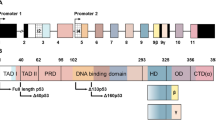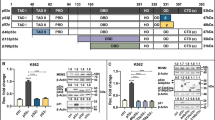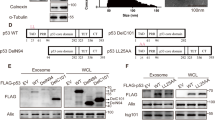Abstract
TSAP6 (tumor suppressor-activated pathway 6), also known as Steap3, is a direct p53 transcriptional target gene. It regulates protein secretion, for example translationally controlled tumor protein (TCTP), which is implicated in tumor reversion. In keeping with the latter, we show herein that TSAP6 is a glycosylated protein present in the trans-Golgi network, endosomal–vesicular compartment and cytoplasmic membrane. To further investigate the physiological function of TSAP6, we have generated TSAP6-deficient mice. These mice exhibit microcytic anemia with abnormal reticulocyte maturation and deficient transferrin receptor downregulation, a process known to be dependent on exosomal secretion. Moreover, we provide direct evidence that exosome production is severely compromised in TSAP6-null cells. Finally, we show that the DNA damage-induced p53-dependent nonclassical exosomal secretory pathway is abrogated in TSAP6-null cells. Given the fact that exosomes are used as cell-free vaccines against cancer and that they could be involved in the biogenesis and spread of human immunodeficiency virus, it is important to understand their regulation. The results presented here provide the first genetic demonstration that exosome formation is a tightly controlled biological process dependent of TSAP6.
Similar content being viewed by others
Log in or create a free account to read this content
Gain free access to this article, as well as selected content from this journal and more on nature.com
or
Abbreviations
- TSAP6:
-
tumor suppressor-activated pathway 6
- TCTP:
-
translationally controlled tumor protein
- MEFs:
-
mouse embryo fibroblasts
- PARP:
-
poly (ADP-ribose) polymerase
- TUNEL:
-
terminal deoxynucleotidyl transferase-mediated dUTP nick end-labeling
- PHZ:
-
Phenylhydrazine
- PFT:
-
Pifithrin
References
Amson RB, Nemani M, Roperch JP, Israeli D, Bougueleret L, Le Gall I et al. Isolation of 10 differentially expressed cDNAs in p53-induced apoptosis: activation of the vertebrate homologue of the Drosophila seven in absentia gene. Proc Natl Acad Sci USA 1996; 93: 3953–3957.
Roperch JP, Alvaro V, Prieur S, Tuynder M, Nemani M, Lethrosne F et al. Inhibition of presenilin 1 expression is promoted by p53 and p21WAF-1 and results in apoptosis and tumor suppression. Nat Med 1998; 4: 835–838.
Passer BJ, Nancy-Portebois V, Amzallag N, Prieur S, Cans C, Roborel de Climens A et al. The p53-inducible TSAP6 gene product regulates apoptosis and the cell cycle and interacts with Nix and the Myt1 kinase. Proc Natl Acad Sci USA 2003; 100: 2284–2289.
Sanchez-Pulido L, Rojas AM, Valencia A, Martinez AC, Andrade MA . ACRATA: a novel electron transfer domain associated to apoptosis and cancer. BMC Cancer 2004; 4: 98.
Ohgami RS, Campagna DR, Greer EL, Antiochos B, McDonald A, Chen J et al. Identification of a ferrireductase required for efficient transferrin-dependent iron uptake in erythroid cells. Nat Genet 2005; 37: 1264–1269.
Amzallag N, Passer BJ, Allanic D, Segura E, Thery C, Goud B et al. TSAP6 facilitates the secretion of translationally controlled tumor protein/histamine-releasing factor via a nonclassical pathway. J Biol Chem 2004; 279: 46104–46112.
Tuynder M, Susini L, Prieur S, Besse S, Fiucci G, Amson R et al. Biological models and genes of tumor reversion: cellular reprogramming through tpt1/TCTP and SIAH-1. Proc Natl Acad Sci USA 2002; 99: 14976–14981.
Susini L, Besse S, Duflaut D, Lespagnol A, Beekman C, Fiucci G et al. TCTP protects from apoptotic cell death by antagonizing bax function. Cell Death Differ 2008 Advance online publication 15 February.
Rubartelli A, Cozzolino F, Talio M, Sitia R . A novel secretory pathway for interleukin-1 beta, a protein lacking a signal sequence. EMBO J 1990; 9: 1503–1510.
Hughes RC . Secretion of the galectin family of mammalian carbohydrate-binding proteins. Biochim Biophys Acta 1999; 1473: 172–185.
Nickel W . The mystery of nonclassical protein secretion. A current view on cargo proteins and potential export routes. Eur J Biochem 2003; 270: 2109–2119.
Pan BT, Johnstone RM . Fate of the transferrin receptor during maturation of sheep reticulocytes in vitro: selective externalization of the receptor. Cell 1983; 33: 967–978.
Johnstone RM . Revisiting the road to the discovery of exosomes. Blood Cells Mol Dis 2005; 34: 214–219.
Gould SJ, Booth AM, Hildreth JE . The Trojan exosome hypothesis. Proc Natl Acad Sci USA 2003; 100: 10592–10597.
Nguyen DG, Booth A, Gould SJ, Hildreth JE . Evidence that HIV budding in primary macrophages occurs through the exosome release pathway. J Biol Chem 2003; 278: 52347–52354.
Raposo G, Nijman HW, Stoorvogel W, Liejendekker R, Harding CV, Melief CJ et al. B lymphocytes secrete antigen-presenting vesicles. J Exp Med 1996; 183: 1161–1172.
Thery C, Zitvogel L, Amigorena S . Exosomes: composition, biogenesis and function. Nat Rev Immunol 2002; 2: 569–579.
Zitvogel L, Regnault A, Lozier A, Wolfers J, Flament C, Tenza D et al. Eradication of established murine tumors using a novel cell-free vaccine: dendritic cell-derived exosomes. Nat Med 1998; 4: 594–600.
Yu X, Harris SL, Levine AJ . The regulation of exosome secretion: a novel function of the p53 protein. Cancer Res 2006; 66: 4795–4801.
de Gassart A, Geminard C, Hoekstra D, Vidal M . Exosome secretion: the art of reutilizing nonrecycled proteins? Traffic 2004; 5: 896–903.
Ross SR, Schofield JJ, Farr CJ, Bucan M . Mouse transferrin receptor 1 is the cell entry receptor for mouse mammary tumor virus. Proc Natl Acad Sci USA 2002; 99: 12386–12390.
Burzyn D, Rassa JC, Kim D, Nepomnaschy I, Ross SR, Piazzon I . Toll-like receptor 4-dependent activation of dendritic cells by a retrovirus. J Virol 2004; 78: 576–584.
Aisen P . Transferrin receptor 1. Int J Biochem Cell Biol 2004; 36: 2137–2143.
Vidal M, Mangeat P, Hoekstra D . Aggregation reroutes molecules from a recycling to a vesicle-mediated secretion pathway during reticulocyte maturation. J Cell Sci 1997; 110 (Part 16): 1867–1877.
Savina A, Vidal M, Colombo MI . The exosome pathway in K562 cells is regulated by Rab11. J Cell Sci 2002; 115: 2505–2515.
Clayton A, Turkes A, Navabi H, Mason MD, Tabi Z . Induction of heat shock proteins in B-cell exosomes. J Cell Sci 2005; 118: 3631–3638.
Lancaster GI, Febbraio MA . Exosome-dependent trafficking of HSP70: a novel secretory pathway for cellular stress proteins. J Biol Chem 2005; 280: 23349–23355.
Komarov PG, Komarova EA, Kondratov RV, Christov-Tselkov K, Coon JS, Chernov MV et al. A chemical inhibitor of p53 that protects mice from the side effects of cancer therapy. Science 1999; 285: 1733–1737.
Dameron KM, Volpert OV, Tainsky MA, Bouck N . Control of angiogenesis in fibroblasts by p53 regulation of thrombospondin-1. Science 1994; 265: 1582–1584.
Kunz C, Pebler S, Otte J, von der Ahe D . Differential regulation of plasminogen activator and inhibitor gene transcription by the tumor suppressor p53. Nucleic Acids Res 1995; 23: 3710–3717.
Buckbinder L, Talbott R, Velasco-Miguel S, Takenaka I, Faha B, Seizinger BR et al. Induction of the growth inhibitor IGF-binding protein 3 by p53. Nature 1995; 377: 646–649.
Komarova EA, Diatchenko L, Rokhlin OW, Hill JE, Wang ZJ, Krivokrysenko VI et al. Stress-induced secretion of growth inhibitors: a novel tumor suppressor function of p53. Oncogene 1998; 17: 1089–1096.
Zou Z, Gao C, Nagaich AK, Connell T, Saito S, Moul JW et al. p53 regulates the expression of the tumor suppressor gene maspin. J Biol Chem 2000; 275: 6051–6054.
Rodriguez-Boulan E, Kreitzer G, Musch A . Organization of vesicular trafficking in epithelia. Nat Rev Mol Cell Biol 2005; 6: 233–247.
Delacour D, Cramm-Behrens CI, Drobecq H, Le Bivic A, Naim HY, Jacob R . Requirement for galectin-3 in apical protein sorting. Curr Biol 2006; 16: 408–414.
Thery C, Boussac M, Veron P, Ricciardi-Castagnoli P, Raposo G, Garin J et al. Proteomic analysis of dendritic cell-derived exosomes: a secreted subcellular compartment distinct from apoptotic vesicles. J Immunol 2001; 166: 7309–7318.
Bonifacino JS . The GGA proteins: adaptors on the move. Nat Rev Mol Cell Biol 2004; 5: 23–32.
Mallet WG, Maxfield FR . Chimeric forms of furin and TGN38 are transported with the plasma membrane in the trans-Golgi network via distinct endosomal pathways. J Cell Biol 1999; 146: 345–359.
Blot G, Janvier K, Le Panse S, Benarous R, Berlioz-Torrent C . Targeting of the human immunodeficiency virus type 1 envelope to the trans-Golgi network through binding to TIP47 is required for env incorporation into virions and infectivity. J Virol 2003; 77: 6931–6945.
Blanc L, Barres C, Bette-Bobillo P, Vidal M . Reticulocyte-secreted exosomes bind natural IgM antibodies: involvement of a ROS-activatable endosomal phospholipase iPLA2. Blood 2007; 110: 3407–3416.
Acknowledgements
This study is part of the PhD thesis of Alexandra Lespagnol (Université Paris VII), and Dominique Duflaut (Université Paris XI). We are grateful to Tania Sorg and Daniel Metzger for their advice in the generation of the TSAP6 knockout mice, to Alain Schmitt, Marie-Claude Gendron, Myriam Garfa, and Evelyne Souil for their expertize, Naomi Taylor for her scientific and technical help and Marie-Claude Guillemin for the bone marrow analysis and Pierre Hainaut for his constructive comments. We thank Séverine Beaucourt for her involvement in the initial experiments (see PhD thesis online: These_Severine_Beaucourt.pdf). CB is supported by grants from the Belgian Foundation for Cancer Research. This work was supported by grants from ARC (no. 3444) to MV, Conticanet (Network of Excellence) and Eureka from the European Commission to AT and RA.
Author information
Authors and Affiliations
Corresponding author
Additional information
Edited by KH Vousden
Competing interests statement
The authors declare that they have no competing financial interests.
Supplementary Information accompanies the paper on Cell Death and Differentiation website (http://www.nature.com/cdd)
Supplementary information
Rights and permissions
About this article
Cite this article
Lespagnol, A., Duflaut, D., Beekman, C. et al. Exosome secretion, including the DNA damage-induced p53-dependent secretory pathway, is severely compromised in TSAP6/Steap3-null mice. Cell Death Differ 15, 1723–1733 (2008). https://doi.org/10.1038/cdd.2008.104
Received:
Revised:
Accepted:
Published:
Issue date:
DOI: https://doi.org/10.1038/cdd.2008.104
Keywords
This article is cited by
-
A novel therapeutic strategy: the significance of exosomal miRNAs in acute myeloid leukemia
Medical Oncology (2024)
-
HDAC5-mediated exosomal Maspin and miR-151a-3p as biomarkers for enhancing radiation treatment sensitivity in hepatocellular carcinoma
Biomaterials Research (2023)
-
SOCS2-enhanced ubiquitination of SLC7A11 promotes ferroptosis and radiosensitization in hepatocellular carcinoma
Cell Death & Differentiation (2023)
-
Enhanced oxidative phosphorylation, re-organized intracellular signaling, and epigenetic de-silencing as revealed by oligodendrocyte translatome analysis after contusive spinal cord injury
Scientific Reports (2023)
-
Different impacts of TP53 mutations on cell cycle-related gene expression among cancer types
Scientific Reports (2023)



